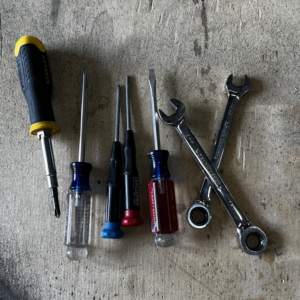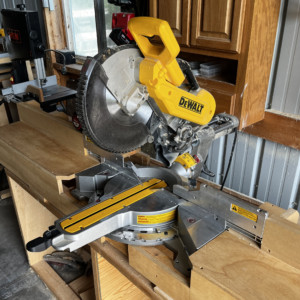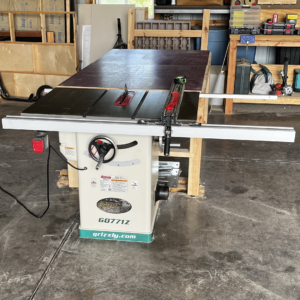What Tools do you really need?
Depending on the types of projects you are interested in, this is kind of a loaded question. Over the years, my shop has acquired a basic setup for most of these disciplines, but generally speaking, for each of them my setups are still pretty minimal. I will share what I am currently using, and where I came from in the cases where I have upgraded.
I am going to break these into a few categories, and unless a project demanded something specific, this is the order I would purchase in, if I had to do it again.
Tier 1 – Can’t live without these in my shop and would recommend these right away if you don’t yet have them.
Tier 2 – Where to look if I you’re ready to start growing. I’d still call these basics, and are all the tools that make it easier to create basic projects.
Tier 3 – Your projects are getting more complex, but you can live without them if needed.
Tier 4 – If its not in this list, I place it in this category. These are the tools to not start drooling over until you REALLY need them.
Disclaimer: While I do believe that a quality tool will last a lifetime, many of my choices below will also firm up my belief that budget tools definitely have their place. A low quality band saw is better than not having a band saw when you need one. Tool quality snobs, please go elsewhere for this list. There is no need to have top of the line tools if you can’t afford them. As I grow older and money is less tight, I am slowly migrating to the buy right, buy once mentality, but this is definitely not where you need to start.
Disclaimer 2: All of this links are to my Amazon Affiliate store and will provide me some income. This blog is a spendy endeavor and I would appreciate using them to help support these projects and the time it takes to create the writeups!
The all around essentials.
I know one of these is generally considered a woodworking tool, but even when working with metal, I will almost always prototype with some good ol’ reliable, and more importantly CHEAP pine. Messing up a metal project can be incredibly costly in both time and money. Cut a piece the wrong size AND had it welded on already, welcome to the projects pains!
Basic Hand Tools (Tier 1)
This includes your screwdrivers, sockets, wrenches, Hex Wrenches etc. I think brand doesn’t matter a ton here as long as you have something that functions. I have been tremendously happy with my Harbor Freight Quinn series for sockets. I bought a huge variety pack of Craftsmen screwdrivers and have a couple multi-bit drivers. Ratcheting wrenches, tremendously wonderful, but any standard box wrench set will get the job done.

A Good drill…or two (Tier 1)
This is my absolute workhorse and I don’t think I have done a single project where it wasn’t used. I am currently using a Milwaukee M18 1/2″ hammer drill as my primary, but am still using an old Makita 12v, one of their original lithium series drills. I recall buying the combo kit over a decade ago for under $200, and this smaller drill still gets a lot of use.

Miter Saw (Tier 1)
From cutting boards for a shelf, to lobbing off 2×4’s for your first sim rig, this is my Jack of All trades saw. Currently I have a DeWalt DWS779 12″ compound sliding saw. I purchased this on sale for about $350 and see little reason to ever need to upgrade this thing. Originally I had bought a small 7 1/4″ sliding Craftsman, which I made it with for years before deciding to upgrade. Some of my woodworking projects have required 12″ cross cuts, which was just a little bit bigger than the little Craftsman could do.

Other all arounders
These items also cross the project boundaries and I use them frequently for woodworking, metalworking and occasionally electronics.
Drill press (Tier 2)
This is absolutely not a necessary tool, but I do find myself using it much more than I thought. You can do everything this does with the hand drill above, but its nice to ensure that holes line up, and are perpendicular to surfaces. Think alignment when drilling a through-hole in some metal tubing. I stuck to my favorite budget tool brand here, Wen. I have the 4214T. This definitely falls in the, good enough to get it done category, which is where most of my tools still lie. Generally speaking this does everything I have thrown at it, but the spindle has just a hint of wobble, but if I had to do it again, I would have stuck with this choice.

Clamps (Tier 2)
The sign of a pro is how many clamps they have. If I’ve learned anything from the YouTubes, its that. All joking aside, I don’t think I’ve done many projects where a couple clamps weren’t a necessity. Started out with a 4 pack of Irwin Quick Clamps nearly a decade ago, and they are still holding strong! Harbor Freight is also a great source for budget clamps to get you started.

Band Saw (Tier 3)
Also a Wen here. Went with the cheapest free standing version. The 3962T. Again in the good enough to get it done category once it got a real blade installed. It makes some strange squeaks, and took a bit of fiddling to get it cutting accurate, but I feel like this was a decent choice I would make again.

Woodworking
Circular Saw (Tier 2)
I would generally prefer my table saw to a circular saw, but this much cheaper alternative can definitely get a lot of projects done. Unless you plan on ripping small boards, this would be a good place to start.
Table Saw (Tier 2)
This one barely makes my list of ESSENTIAL tools, but alas, it was the 3rd major tool I purchased and it still gets regular use in many classifications of project. I recently upgraded to a Grizzly G0771z. This is the lower end of their cabinet saws, but since my shop finally had space to allow a permanent saw setup and I had a relatively low budget for this bigger tier of saw, this is where I landed. I thoroughly enjoy this thing, even running in 120v mode. Prior to the Grizzly, I continue the DeWalt trend in my early maker career, and started with one of those portable little jobsite saws. The model I had is no longer made, but was replaced by the DeWalt DWE7485. While I made it a lot of years with this saw, I wish I would have spent a little more because of the limited rip capacity. I thought a 20″ capacity was plenty, thinking I can just spin the board if I need anything wider. BUT you soon realize just how many rips you need to make at 24″ which this thing is incapable of. If that budget is not suitable, you could always swap the table saw for a circular saw. A tool I now have, but is a bit harder to do any precision work. See below for that recommendation.

Pocket Hole Jig (Tier 2)
Early in my building career, I never would have though this would make the list, but this cheap little tool saves you from all kinds difficult joinery that requires much more expensive tools. I am using the Kreg R3 basic kit.
A Router (Tier 3)
I don’t use this terribly often, so I would definitely leave it as a lower priority when getting started. But it does have some time saving potential rounding edges, and for pattern jigs. Currently its sitting on top of my DIY router table, which was built cheaper than the off the shelf bench top models.

Metalworking
Angle Grinder (Tier 2)
This is another tool I use WAY more than I thought I would. A cutting wheel and a flap disc can tackle all kinds of tasks. Rounding edges, cutting stock, carving wood, stripping paint, you name it….People do some incredible cutting with these things, which I have never successfully done, but with practice, you could probably omit the chop saw below. I am using a Makita 4″ GA4030. If I had to buy this again, I would probably spend a little more money and go with a 4 1/2″ which seems to be more of a standard size, based on discs found at my local shops, but I have been perfectly happy with this thing.

Chop saw (Tier 2)
I hate this thing, not because of the quality of the tool, but because its ridiculously loud, and makes a terrible mess, and leaves some real rough edges. I wish I could have afforded a horizontal band saw for cutting my raw stock, but I couldn’t. We are back to DeWalt here with the D28730. Again, from a tool quality standpoint, this thing is perfect, its just not a tool I would purchase if I could afford the horizontal band saw.
A Welder (Tier 3)
I list this as a tier 3, because most things can still be bolted together without having to weld, and I did this for a LOT of years. The harbor freight special here. The Titanium Mig-140. Ill admit, when I bought this it was much cheaper. Given the current price, I might look elsewhere, but at 100 bucks cheaper, this thing is perfectly capable of sticking metal together. (My Gloves and mask, also from harbor freight, and I do really like the quality of those at their price point)
Honorable Mentions
A 3d Printer
Honestly, I bought one of these on a whim years ago, this tool has transformed how I do MANY things and opened up my world to what I can create. From creating little jigs for woodworking, components for my electronics projects, all kinds of parts for my sim rigs, custom organizers, you can do it all here. I started on a Creality Ender 3 v1 pro, and struggled to ever get it to print reliably. It just took too much fussing about. I recently upgraded to a Bambu P1 and couldn’t be happier. It just works, which lets me focus on design. They have a cheaper A1 series which I hear equally good things about. With the price changes in the 3d printer marker, this is just a tool I feel like all self respecting DIY-ers need these days. There are a huge number of functional pintable’s available on the internet, but to take this to the max, you may need to dive into the world of 3d modeling. (its not that hard, I promise)
